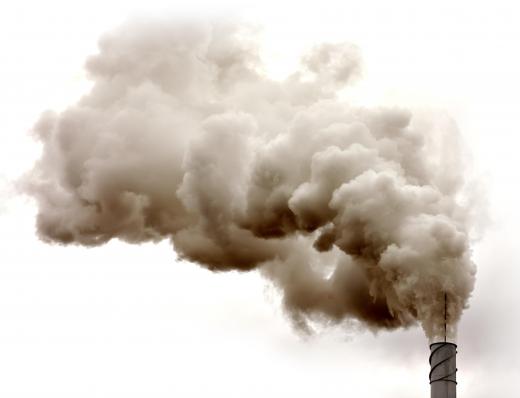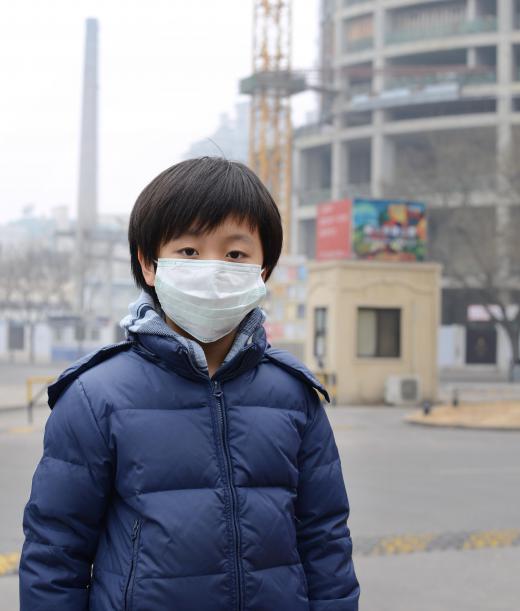In Science, What Is Haze?
 Mary McMahon
Mary McMahon
Haze is an airborne mix of air pollution, dust, and smoke that impairs visibility and interacts with the natural environment. It can be anthropogenic or natural in origin and plays a role in weather conditions and climate change. Researchers have dedicated substantial attention to this phenomenon since the 1970s, when climate scientists first became aware of the role haze plays in meteorology and overall climate trends. Studies on this topic frequently appear in professional journals dedicated to meteorology and climate research.
This mixture can include an assortment of aerosolized pollutants, including small particulates like soot, along with gases vented from industrial manufacturing facilities. It may be brown to blue in color and can create a plume across the landscape. While not always immediately visible to the naked eye, haze can show up in imaging studies, particularly with the use of filters to polarize the landscape and make patterns in the air more visible.

Particles in the haze can block and absorb sunshine, changing the way light behaves. This can be observed at dawn and dusk, where the light may appear especially vivid or strange because of the way the haze interrupts the transmission of light. The mixture can also appear with other pollutants like smog, and may create layers of pollution that can become trapped in areas like valleys and natural depressions in the earth, along with harbors and other low-lying areas.

Visually, it can be a problem because it cuts down on visibility. This can be an issue for navigation, photography, scientific observations, and other activities. Navigational issues can be a special concern for large craft that cannot easily stop or turn to avoid hazards. Photographers may notice, for instance, that haze obscures images shot at or near the horizon. It may be necessary to use special lenses and other tools for visibility.
Beyond visibility, haze also poses a risk to the climate. The particulates can create pockets of increased humidity and may impact precipitation rates and cloud formation. It can also contribute to warming and cooling trends by changing air patterns and the transmission of light from the sun. Furthermore, it can be a threat to human health and safety, as it may contain pollutants that enter the airways and cause irritation.
For these reasons, researchers map and track the movement of haze to learn more about how it behaves. Their goal is to prevent it if possible. They also issue advisories to members of the public if it appears set to create health problems.
AS FEATURED ON:
AS FEATURED ON:












Discussion Comments
@indigomoth - Well, the air pollution affects buildings and statues and trees and things as well, so there's all the more reason to try and find a way to stop it.
But, haze isn't just pollution, it also occurs naturally. I often get frustrated by the haze that hovers over the grand canyon and admittedly some of that might be pollution, but a lot of it is just natural dust from the landscape. You have to wait for the rain to settle it.
Of course, some of the dust in some places isn't natural, because it comes from man made erosion.
@pleonasm - It really is destructive though. In China, when Beijing was hosting the Olympics, they actually banned people from using their cars for weeks before the games, just so that the haze would clear. And even then, many of the athletes complained about having to perform in that kind of air quality. And I don't blame them.
Big cities in China are notorious for their increased incidences of lung cancer and other ailments. It's the same in Europe. I visited London a few months ago and I couldn't believe how bad the air quality was. I had heard that London was so much improved by modern technology, considering the thick fogs they used to have there a hundred years ago, but it still made me cough and sniffle walking through town every day.
I hope that these much hyped electric cars will improve the haze in these places because they look bad and it affects people in the worst way.
If you live in an area with haze, you just get used to it, which is hard for someone who isn't used to it to imagine. I visited Los Angles a few years ago and the haze there was incredibly bad. You could hardly see the hills around the city it was so terribly difficult to look through the air for any distance. It made me wonder that the rates of lung cancer aren't higher there (although, I don't actually know the rates, for all I know, they are pretty high).
Then, you go somewhere else in the country, say up the coast, and suddenly it feels like you can see way into the distance and even the faraway mountains look like they are so close you could touch them. I think it's such a vital demonstration of people not acting on what is obviously a bad thing. There are so many people in LA who could do something about this problem and no one has, even though they must all be so aware of it.
Post your comments